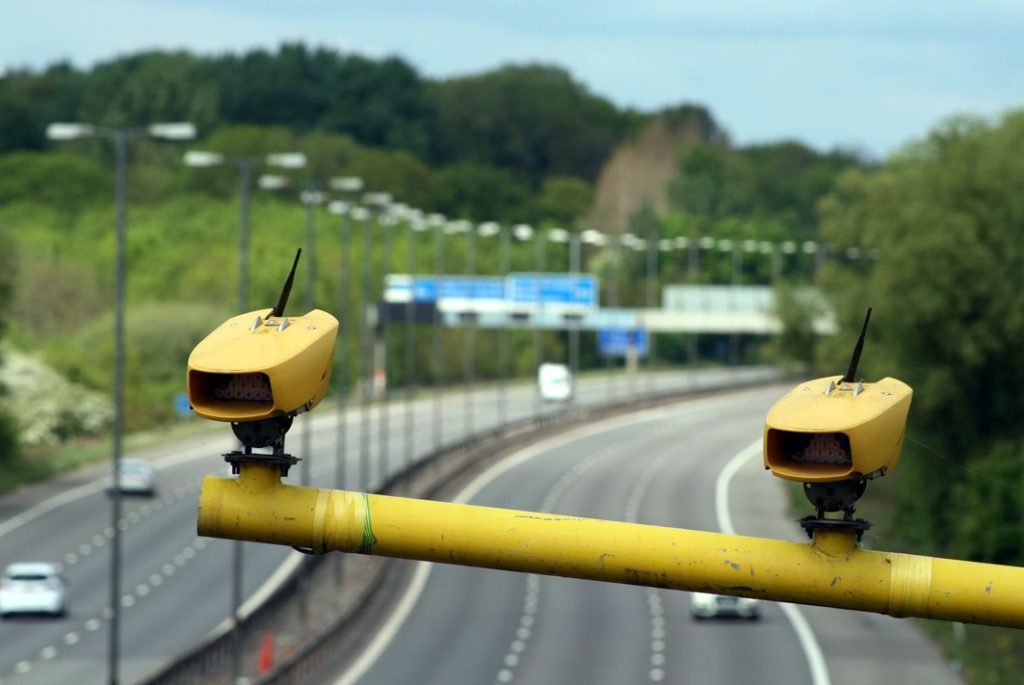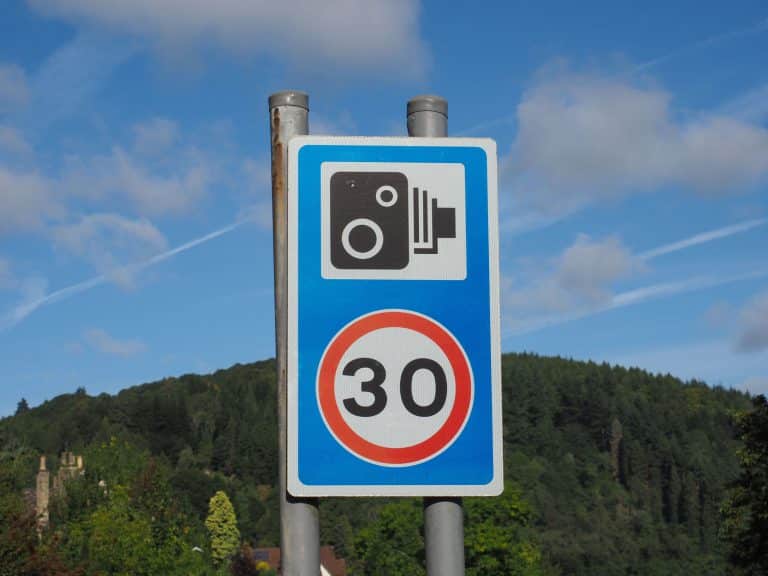Speed cameras are a familiar sight on busy roads up and down the UK. But while it’s easy to slow down for fixed cameras, average speed cameras can be more confusing.
So, how do average speed cameras work? How fast can you drive through one? And can you get a ticket if you’re caught by one?
We’ve got the answers to those questions (and more) below. Let’s dive in.
How do average speed cameras work?
An average speed camera tracks a vehicle’s average speed over a specific stretch of road.
Instead of capturing your speed at a particular moment in time, pairs of cameras work together. These record the time you passed two separate points. They use that information and the distance between the cameras to calculate your average speed (hence the name).
The cameras also record your car’s registration. If your average speed exceeds the speed limit, a ticket is automatically issued to the registered address in your vehicle’s log book (V5C).
Average speed cameras were introduced to stop drivers from slowing down when they saw a speed camera, only to speed up again once they’d passed it. In that way, they also help keep the traffic flowing smoothly.
How fast can you go through average speed cameras?
It’s not the speed you’re going as you pass the cameras that matters. It’s your speed over the distance between the cameras that counts.
Let’s say the average speed check is 50 mph. You pass the first camera at bang on 50 mph. Then you speed up to 70 mph, and slow down again to 50 mph for the second camera.
The system knows how long it should take you to cover the distance between the cameras at 50 mph. If you pass the second camera faster than that, it will know you’ve exceeded the speed limit.
On the other hand, if you pass the first camera at 60mph, then immediately slow to 40 mph, you may escape a ticket. Depending on your braking distance and the gap between the cameras, your average speed may dip below 50 mph.
Do average speed cameras allow 10 percent plus 2 leeway?
You may have heard of a “10% plus 2” rule when it comes to speed cameras. The idea is that if the speed limit is, say, 50 mph, you can go 10% plus 2 mph over and not be penalised for speeding. In this example, you’d need to travel faster than 57 mph to receive a speeding ticket.
However, while some police forces will overlook speeding offences that fall within the “10% plus 2” range, it’s not a hard and fast rule. You can still be issued a speeding ticket for going just 1 mph over the speed limit.
The safest option is not to try and trick the cameras. Drive at or below the speed limit, and you’ll avoid a fine!
Can you get a speeding ticket from average speeding cameras?
Yes, you can. If your average speed is above the speed limit, the camera system will use Automatic Number Plate Recognition (ANPR) to find the car’s registered address.
You’ll receive a Notice of Intended Prosecution (NIP) within two weeks of being caught speeding. This will include:
- Your registration details
- The date and time of the alleged traffic offence
- The location of the alleged offence
- The type of offence that was committed by the driver (i.e., speeding)
Note: The NIP will ask you to provide the driver’s details, in case you weren’t the one driving at the time.
What do you need to do if you receive a Notice of Intended Prosecution?
You must respond to a Notice of Intended Prosecution within 28 days of receiving it. Even if you weren’t the one driving, you can’t ignore it. You must give the police the driver’s details.
If you don’t respond with all the required information, you could face prosecution, six points on your licence, and a fine of up to £1,000.
Once you have a NIP, you have two options:
- Respond with a guilty plea and accept the penalty.
- Respond with a not guilty plea and go to court.
If you choose to plead not guilty, be aware that costs can climb. Depending on the nature and seriousness of the offence, you may need to hire legal representation to defend yourself in court. And you might still end up with a fine (perhaps even a higher one), the points, and a driving ban.
What is the penalty for speeding in the UK?
The minimum penalty for speeding in the UK is a £100 fine and three points on your licence. But it all depends on the nature of the offence.
The authorities might be more lenient if it’s your first violation and you don’t already have points on your licence. Instead of points and a fine, you could be offered a speed awareness course to educate you about the dangers of speeding.
These courses tend to be virtual, although in-person options are available too. They last up to 2.5 hours, and you need to pay to attend one.
If you were channelling your inner Lewis Hamilton, though, a speed awareness course is unlikely to be an option. And the penalty you face could be much higher. You might even be summoned to court for dangerous driving, and you could be looking at a ban.
How to avoid being fined by an average speed camera
Short answer? Don’t speed.
Sometimes, however, that’s easier said than done. When you’re driving on long, quiet stretches of road, your speed can creep up without you realising.
If your car has it, use cruise control to maintain the correct speed. Otherwise, check your speed regularly and pay attention to warnings from your GPS or sat nav.
Speed camera FAQs
Do average speed cameras flash?
No, they don’t. Unlike other types of speed cameras, there’s no tell-tale “double flash” tipping you off to a speeding offence.
And if you think “no flash” means “no fine”, think again! Average speed cameras use invisible infrared to illuminate your number plate. So even if you haven’t seen the camera, the chances are, it’s seen you.
Do average speed cameras take pictures of the driver?
Some do, and some don’t. It all depends on the design. That’s why it’s important to respond to a NIP swiftly, even if you weren’t the one driving. If someone else was speeding in your car and you don’t identify them, you’ll be left to take the punishment.
Does an average speed camera need to be visible?
Back in October 2016, the Department for Transport determined that all speed cameras should be painted yellow. This makes them hard to miss on most roads and motorways.
However, even if you don’t spot a speed camera, you can’t use that as an excuse for speeding. Stick to the speed limit, and it won’t matter what colour they are!

Do average speed cameras work at night?
Yes, they do. Even though they don’t flash, infrared cameras can capture clear images day or night, no matter the weather.
Does stopping or swapping lanes fool the cameras?
Average speed cameras are pretty smart. They can cross-compare lanes, so weaving through traffic won’t fool them. And unless you stop between paired cameras (hard to do, as many are only 200 metres apart), you won’t avoid having your average speed recorded.
Can speed cameras catch you from the front?
It depends on the type of camera. Some are rear-facing and will only capture your vehicle once you’ve passed it. Others capture both the front and rear of your vehicle. And some can even snap a photo of the driver.
Other types of speed cameras in the UK
Average speed cameras aren’t the only ones monitoring your speed and driving on British roads. There are over a dozen different kinds of speed cameras in operation today in the UK. They fall into the following broad categories:
- Fixed speed cameras: These cameras record the speed you’re going as you pass them at a particular spot. They usually (but not always) flash when you’re caught speeding.
The first fixed speed camera was introduced on the M40 in 1991. Back then, they used film to capture speeding drivers, but today they’re all digital.
Fixed speed cameras take two pictures in quick succession, comparing your vehicle’s position on the white lines in both photos to work out your speed.
- Traffic cameras: These cameras have a dual purpose. Using radar, they can capture and record speeding motorists. But they also monitor offences at traffic lights (i.e., running red lights).
- Mobile speed cameras: This category covers any type of handheld or portable speed camera, including police car speed cameras and laser guns. Officers sitting in a car or van can detect speeding drivers up to 1 kilometre away.
Some cameras can also be used to spot drivers using their mobile phones, or people not wearing their seatbelts.
Quickfire summary
To recap, how do average speed cameras work? They record the times you passed two linked cameras, calculating your average speed from point A to point B. If that average exceeds the speed limit for that stretch of road, you’ll automatically be issued with a speeding ticket.
Also read:
- Which regions have the highest number of speed cameras?
- What is a speed awareness course?
- Do speeding tickets affect insurance?
- Driving without a valid MOT: what you need to know
- How often should you service your car?
- Buying a new build? Snag lists find 300 faults on average
- ANPR Cameras: all you need to know
- Free MOT status checker – Check a vehicle’s MOT history
- Try our free-to-use Car Tax Checker

